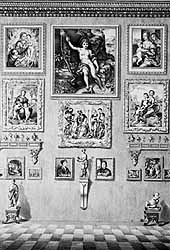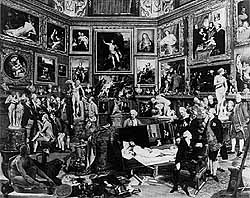
Inside the Tribune
The Tribune is most prestigious and original room in the Uffizi; it is an octagonal room which Francesco I, a gloomy and introverted man, who was however blessed with a refined cultural imagination, commissioned his favourite artist, Bernardo Buontalenti to build. Designed in 1584, the Tribune, with its soaring cupola, stands in the East Corridor of the Gallery and is a momentous element in the architecture of the museum, which is what, in fact, it was supposed to be: it is a sort of enormous treasure chest that was designed to display the Grand Duke's most valuable objects and works of art as well as anything that was particularly unusual or rare.

Francesco
I de' Medici
The schatzkammer (treasury) of the mediaeval Nordic kings is used and evolved here as a model to become a museological conception of the Wunderkammer (room of wonders) of the late Renaissance, which associated works of art with nature's creations in order to stimulate knowledge, pleasure and wonder in the visitor: paintings, medals, little bronzes and goldsmithery were thus displayed alongside fine cut glass, the remains of fossils and rare minerals. The architecture of the room, with its ceilings and frieze encrusted with shell valves (mother-of-pearl), is also carried out according to the Mannerist ideas that united art and nature, and which were also to inspire the hanging gardens on the roof of the Loggia dei Lanzi, which closes the Palace to the West.

View
over the interior of the Tribune Cupola
Buontalenti's brilliant imagination directed the staging of a complex allegory. Each of the architectural ingredients in the Tribune describes the elements of the cosmos (air, earth, fire and water) which are subdued and reduced to forms of beauty by the creative ability of man.
Originally, however, it was furnished with only a few masterpieces of painting which were displayed alongside the medals, precious stones and antique cammeos contained in the 120 drawers lining the ebony console table that ran all round the room, while the silver and bronze sculptures by Giambologna were placed in front of the red velvet covering the walls. The first inventory of this room was apparently made in 1589.

Antique version of the Tribune
Several more famous paintings from the collections of the Grand Duke were added in the 17th century: Raphael (Madonna of the chair and St. John the Baptist in the desert), Pontormo Charity), Andrea del Sarto Portrait of a woman), Michelangelo Doni Tondo, mentioned here in documents since 1635), while a series of classical statues in marble, among them the Medici Venus, were placed around a famous table inlaid with precious stones (1680 circa), which had been made in the Florentine Opificio. Some of these paintings are still exhibited in this room, others are now at the Palatine Gallery.

The
Tribune in a painting of Johann Zoffany
The Tribune thus became a museographic environment that was to become famous throughout the world and the ideal reference point for any important collector; in fact, its fame was so great that in 1772 the Queen of England commissioned Zoffany to paint a famous view there which is now at Windsor Castle: some of the most important members of the English colony in Florence are recognizeable in the painting. The original arrangement was very different from that of today, though an attempt was made in 1970 to recreate the general layout of the environment, as far as it was possible. Today the Tribune is room 18 in the Gallery itinerary
